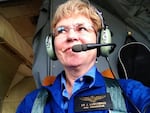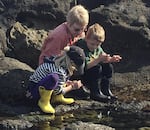Jane Lubchenco has spent most of her life thinking about our relationship with the sea. It's a relationship that continues to amaze her.
“Half the oxygen on planet Earth is produced by plants in the ocean," said the Oregon State University distinguished professor.
"Oregon Field Guide" first toured the tide pools of Boiler Bay with the eminent marine ecologist in 2003.
By 2009, Lubchenco had ventured into much deeper waters.
That’s when President Barack Obama tapped Lubchenco to head up the National Oceanic and Atmospheric Administration (NOAA). The post gave her influence on the policies that affect the environments she’s been exploring throughout her career.

Dr. Jane Lubchenco in her role as NOAA chief confers with President Barack Obama, Science Advisor Dr. John Holdren and Coast Guard Commandant Thad Allen about the PB Deepwater Horizon disaster, 2010.
The White House
“I’ve started focusing not just on discovering how ocean ecosystems work," she said, "but tracking how they're changing and thinking about how can we do a better job of managing our activities that are affecting the oceans that provide so many things that we want and need.”
Lubchenco and her husband, fellow-OSU marine ecologist Bruce Menge, moved to Oregon from the East Coast 40 years ago.
On this day, Menge and Lubchenco were tide-pooling with their grandchildren near Cape Foulweather. The intertidal zone on this small point of land supplies the kids with the endless delights of chasing hermit crabs and feeling the squishy tentacles of anemones close around tiny fingers. It’s also where study sites that were set up during the couple’s early years at OSU are now providing important long-term data.
Here, nestled between the vivid, life-filled tide pools are a collection of small wire-mesh boxes and colored knobs that track environmental changes occurring at exact locations over time.
“This place has been such a phenomenal laboratory,” Lubchenco said of the Oregon Coast. “There are very few places in the world that have the long-term data that we do.”
Data collected here and at many other sites allow researchers like Lubchenco to explore why things are changing, as well as differentiate between those patterns that are just routine fluctuations and others that suggest something really abnormal is happening.
Those findings indicate that sea levels are rising and that the world’s oceans are becoming warmer and more acidic, and contain less oxygen.
“The most likely explanation for why we're seeing this are changes that are related to climate change,” Lubchenco said.
One example is the appearance of “dead zones” off the Oregon Coast. As ocean and land temperatures rise, wind patterns change, increasing the upwelling of nutrient-rich water and disrupting the ocean ecosystem.
“Normally, as the wind blows along the coast, it pushes surface water away from the coast because the earth is rotating,” Lubchenco explains. “That cold, nutrient-rich upwelling normally produces the really wonderful rich fisheries that we have along the coast here.”
“But if there’s too much nutrient, the herbivores that would naturally eat those microscopic plants can't keep up, and a lot of those plants begin to die,” she said. “Bacteria begin to decompose them, and the bacteria use up all the oxygen in the water.”
This reduced-oxygen condition is known as "hypoxia" and, since the early 2000s, has resulted in local dead zones.

NOAA chief Jane Lubchenco aboard the agency's Hurricane Hunter aircraft during Tropical Storm Issac, 2012. The storm was later upgraded to hurricane status.
Jane Lubchenco
Here near Cape Foulweather, those larger dynamics get hyper-local.
“The [continental] shelf here is very narrow so when people are whale watching, the whales are coming in nice and close to the shore," Lubchenco said. "Down near Cape Perpetua, the shelf is much wider.”
This difference in shelf size is important not just for whale watching. Cape Perpetua’s wider shelf creates a gyre that circulates and concentrates the nutrient-rich plankton blooms and other conditions that are generated by upwelling. The result is a concentration of hypoxia that makes the waters off Cape Perpetua more prone to dead zones than those of Cape Foulweather.
Science Diplomacy
After Lubchenco stepped down from her role at NOAA in 2014, she remained involved in the world of international environmental policy as a science envoy for two years on behalf of the U.S. Department of State. While in her role as a "science diplomat," Lubchenco initiated several international projects that keep her involved in a broad sweep on topics including climate change, ocean health and fisheries.
Lubchenco has also kept busy in her post-NOAA years by teaching students at OSU how to effectively navigate the complex worlds of science policy, management and public information.
At OSU, Lubchenco’s mission is to give her students “opportunities to understand how they can contribute either solutions or change in public awareness, or provide innovative new policies that might be a lot smarter.”
And there is no time to waste in making those changes and innovations, Lubchenco admits.
“It's clear from what we've documented and observed that the earth is changing, sometimes in some very subtle ways, sometimes more dramatic ways," she said. "We're seeing more heat waves. We're seeing more extreme rainfall events, also more droughts. We're seeing changes in the ocean, like bleaching of coral reefs. And all of those are telling us that we need to, in a very urgent way, pay attention and decrease carbon emissions.”

Distinguished Professor Jane Lubchenco of Oregon State University tide-pooling with her grandchildren Elin and Alistair Menge on the central Oregon coast.
Jule Gilfillan / OPB
Still, Lubchenco remains an optimist.
“I derive hope from the fact that there are so many good things that are happening,” she said.
Among those are advancements in the management of fisheries around the world and the development of “blue parks” — the ocean equivalents of terrestrial parks — to protect genetic diversity and increase the chances of ocean life adapting to warmer, more acidic waters.
“So we need to buy time and create the conditions with protected areas, with well-managed fisheries so that we can make it through some of the bottlenecks that are coming and still have a world where my grandkids have wonderful tide pools to explore, and a habitable planet," Lubchenco said. "That's my hope."
From the video vault: Watch "Oregon Field Guide's" 2003 trip to the Oregon coast with Jane Lubchanco

